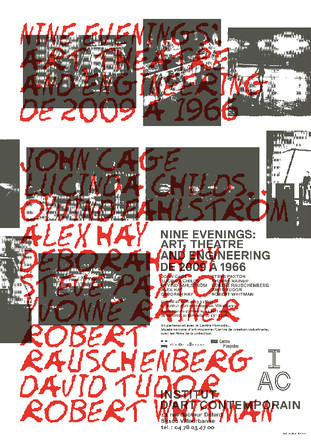At a time when happenings and performance art are the subject of various new focuses, Institut d’art contemporain is now giving 'new life' to 9 Evenings by choosing to spatialise the presentation of the films to recount not only the visual trace of the event but also its dimension of novelty and performance, from 2009 to 1966.
The presentation of the 9 Evenings is also part of the reflection conducted by the Institute on the possible relations between art and the sciences. Thus IAC is shortly to launch a 'laboratory' to explore the relations between space and brain in the field of practice in the arts and cognitive sciences.
9 Evenings: Art, Theatre and Engineering
In the early 1960s, Billy Kluver worked in New York with artists exploring new materials and testing new techniques. He was interested in the social implications of science and technology and began to believe that art and science could not only meet on a practical basis but also a physical one. He developed the idea that close collaboration between artists, engineers and scientists could meet the aspirations of those who wished to work with new techniques and make pieces that could not have been achieved in another way.
E.A.T., Experiments in Art and Technology, was founded in November 1966 by the engineers Billy Kluver and Fred Waldhauer and the artists Robert Rauschenberg and Robert Whitman. The aim of E.A.T was to foster collaboration between artists, engineers and scientists. This was the framework for the presentation of 9 Evenings: Theatre and Engineering, a series of performances combining theatre, dance and image, at the 69th Regiment Armory in New York from 13 to 23 October 1966. Thirty Bell Telephone technicians thus collaborated in works by John Cage, Lucinda Childs, Öyvind Fahlström, Robert Rauschenberg, Robert Whitman and others. The ten mythical performances, mostly entirely new, were given in nine nights and were filmed by the filmmaker and artist Alfons Schilling. The set is shown unabridged today for the first time at an exhibition.


